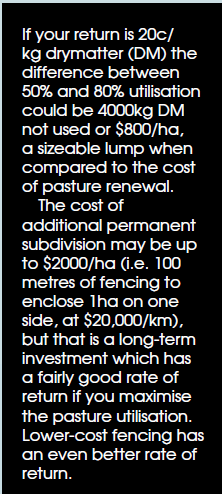Pasture renewal
The end of 2021 has seen rampant inflation in farm costs. Pasture renewal that cost about $1000/ha a year ago is now looking to be closer to $1250/ha or higher.

The end of 2021 has seen rampant inflation in farm costs. Pasture renewal that cost about $1000/ha a year ago is now looking to be closer to $1250/ha or higher. Meat and milk prices have risen also but it might be time to consider what you are aiming to achieve with pasture renewal.
We may want to grow more grass on our farms, but can we harvest more at a profit? The three key things to consider as part of the deal are: subdivision, stock water and species.
Pasture renewal is aimed at improving both pasture quantity and quality, the real benefit comes if you can harvest more of that and turn it into saleable product.
Pasture utilisation is the proportion of pasture grown actually consumed by our grazing stock. While much work has been done on measuring pasture growth, far less has been done on calculating utilisation.
Most estimates of pasture utilisation show a wide range from under 50% to maybe 80% with tight management of high-quality pastures. The well-known key to high utilisation of pasture is rotational grazing at well-planned intervals. To do that requires getting the mob sizes to fit the paddock size to allow a short grazing period and a reasonable recovery period; which generally means more subdivision.

To make the most of the subdivision you may need to extend your stock water reticulation, another cost. Typically farm stock water systems are costed at about $200/ha on a whole-farm basis, so what is it going to cost you to add some pipe and troughs to an existing system?
The catch is that if you don’t extend the water system you don’t maximise the benefit of either the pasture renewal or the additional subdivision, it is a package deal.
The other important factor to consider is species, which is a double-barrel item being pasture species and stock species/class.
After 35 years of farming and consultancy it still irritates me to watch pasture production decline rapidly three to five years after being sown. We know new pastures are more productive than old pastures but I want a mix that is still looking reasonable by the time we look at renewing it at about 10 years of age.
I use the analogy that sprinters seldom last a marathon distance. A fast-establishing species that looks great in the first couple of years is not going to be looking so good at years five-10 unless you can pamper it through any challenges. Consider what species can handle your environment and management over the longer term and consider a mix of species and cultivars for longevity. I am not suggesting a 20-species mix including sunflowers, our agronomy knowledge is actually better than having to use a blunderbuss approach.
A consideration if you extend your pasture mix is to fit your sowing times, rates, sowing methods and early grazing to fit that mix, which might well mean changing your management systems. More commonly farmers will expect new pastures to fit existing management but is that giving the best results short and long term?
Also think about how you are going to use the new pasture – what stock is going to give you the best return from the new pasture?
Finishing lambs or cattle might give a return of 30c/kg DM while breeding ewes on maintenance are well under 20c/kg DM for much of the year. An autumn-sown new pasture grazed by ewes pre-lamb is going to return up to 60c/kg DM, a better return than feeding them a maintenance ration of brassica at the same time.
To get the best return on pasture renewal, have a good think about the big picture. Additional subdivision and water reticulation are a longer-term investment that allow improved pasture utilisation which improve the return on overall investment. Consider what stock will give you the best return at various times, and consider that management might have to change.




